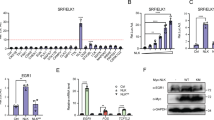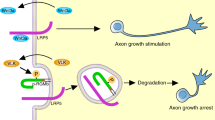Abstract
Activation of mitogen-activated protein (MAP) kinase (also known as extracellular-signal-regulated kinase, or ERK)1 by growth factors can trigger either cell growth or differentiation. The intracellular signals that couple growth factors to MAP kinase may determine the different effects of growth factors: for example, transient activation of MAP kinase by epidermal growth factor stimulates proliferation of PC12 cells1, whereas they differentiate in response to nerve growth factor, which acts partly by inducing a sustained activation of MAP kinase1. Here we show that activation of MAP kinase by nerve growth factor involves two distinct pathways: the initial activation of MAP kinase requires the small G protein Ras, but its activation is sustained by the small G protein Rap1. Rap1 is activated by CRK adaptor proteins and the guanine-nucleotide-exchange factor C3G, and forms a stable complex with B-Raf, an activator of MAP kinase. Rap1 is required for at least two indices of neuronal differentiation by nerve growth factor: electrical excitability and the induction of neuron-specific genes. We propose that the activation of Rap1 by C3G represents a common mechanism to induce sustained activation of the MAP kinase cascade in cells that express B-Raf.
This is a preview of subscription content, access via your institution
Access options
Subscribe to this journal
Receive 51 print issues and online access
$199.00 per year
only $3.90 per issue
Buy this article
- Purchase on Springer Link
- Instant access to full article PDF
Prices may be subject to local taxes which are calculated during checkout





Similar content being viewed by others
References
Marshall, C. J. Specificity of receptor tyrosine kinase signaling: transient versus sustained extracellular signal-regulated kinase activation. Cell 80, 179–185 (1995).
Dichter, M. A., Tischler, A. S. & Greene, L. A. Nerve growth factor-induced increase in electrical excitability and acetylcholine sensitivity of a rat pheochromocytoma cell line. Nature 268, 501–504 (1977).
Greenberg, M. E., Greene, L. A. & Ziff, E. B. Nerve growth factor and epidermal growth factor induce rapid transient changes in proto-oncogene transcription in PC12 cells. J. Biol. Chem. 260, 14101–14110 (1958).
Cowley, S., Paterson, H., Kemp, P. & Marshall, C. J. Activation of MAP kinase kinase is necessary and sufficient for PC12 differentiation and for transformation of NIH3T3 cells. Cell 77, 841–852 (1994).
Traverse, S.et al. EGF triggers neuronal differentiation of PC12 cells that overexpress the EGF receptor. Curr. Biol. 4, 694–701 (1994).
Pan, M.-G., Wang, Y.-H., Hirsch, D. D., Labudda, K. & Stork, P. J. S. The Wnt-1 proto-oncogene regulates MAP kinase activation by multiple growth factors in PC12 cells. Oncogene 11, 2005–2012 (1995).
Yao, H.et al. Cyclic adenosine monophosphate can convert epidermal growth factor into a differentiating factor in neuronal cells. J. Biol. Chem. 270, 20748–20753 (1995).
Porfiri, E. & McCormick, F. Regulation of epidermal growth factor receptor signaling by phosphorylation of the ras exchange factor hSOS1. J. Biol. Chem. 271, 5871–5877 (1996).
Vossler, M.et al. cAMP activates MAP kinase and Elk-1 through a B-Raf- and Rap1-dependent pathway. Cell 89, 73–82 (1997).
Thomas, S. M., DeMarco, M., D'Arcangelo, G., Halegoua, S. & Brugge, J. S. Ras is essential for nerve growth factor- and phorbol ester-induced tyrosine phosphorylation of MAP kinases. Cell 78, 1031–1040 (1992).
Wood, K. W., Sarnecki, C., Roberts, T. M. & Blenis, J. Ras mediates nerve growth factor receptor modulation of three signal-transducing protein kinases: MAP kinase, raf-1, and RSK. Cell 68, 1041–1050 (1992).
Jaiswal, R. K., Weissinger, E., Kolch, W. & Landreth, G. E. Nerve growth factor-mediated activation of the mitogen-activated protein (MAP) kinase cascade involves a signaling complex containing B-Raf and HSP90. J. Biol. Chem. 271, 23626–23629 (1996).
Ihara, S.et al. Dual control of neurite outgrowth by STAT3 and MAP kinase in PC12 cells stimulated with interleukin-6. EMBO J. 16, 5345–5352 (1997).
Mandel, G., Cooperman, S. S., Maue, R. A., Goodman, R. H. & Brehn, P. Selective induction of brain type II Na+ channels by nerve growth factor. Proc. Natl Acad. Sci. 85, 924–928 (1988).
Fanger, G. R., Erhardt, P., Cooper, G. M. & Maue, R. A. Ras-independent induction of rat brain type II sodium channel expression in nerve growth factor-treated PC12 cells. J. Neurochem. 61, 1977–1980 (1993).
D'Arcangelo, G. & Halegoua, S. Abranched signaling pathway for nerve growth factor is revealed by src-, ras-, and raf-mediated gene inductions. Mol. Cell. Biol. 13, 3146–3155 (1993).
deSouza, S., Lochner, J., Machida, C. M., Matrisian, L. M. & Ciment, G. Anovel NGF-responsive element in the stromelysin-1 (transin) gene that is necessary and sufficient for gene expression in PC12 cells. J. Biol. Chem. 270, 9106–9114 (1995).
Tanaka, S.et al. C3G, a guanine nucleotide-releasing protein expressed ubiquitously, binds to the Src homology 3 domains of CRK and GRB2/ASH proteins. Proc. Natl Acad. Sci. USA 91, 3443–3447 (1994).
Knudsen, B. S., Feller, S. M. & Hanafusa, H. Four proline-rich sequences of the guanine-nucleotide exchange factor C3G bind with unique specificity to the first Src homology 3 domain of Crk. J. Biol. Chem. 269, 32781–32787 (1994).
Gotoh, T.et al. Identification of Rap1 as a target for the Crk SH3 domain-binding guanine nucleotide-releasing factor C3G. Mol. Cell. Biol. 15, 6746–6753 (1995).
Matsuda, M.et al. CRK protein binds to two guanine nucleotide-releasing proteins for the Ras family and modulates nerve growth factor-induced activation of Ras in PC12 cells. Mol. Cell. Biol. 14, 5495–5500 (1994).
Feller, S. M., Knudsen, B. & Hanafusa, H. Cellular proteins binding to the first Src homology 3 (SH3) domain of the proto-oncogene product c-Crk indicate Crk-specific signaling pathways. Oncogene 10, 1465–1473 (1995).
Reedquist, K. A.et al. Stimulation through the T cell receptor induces Cbl association with Crk proteins and the guanine nucleotide exchange protein C3G. J. Biol. Chem. 271, 8435–8442 (1996).
Smit, L., van der Horst, G. & Borst, J. Sos, Vav, and C3G participate in B cell receptor-induced signaling pathways and differentially associate with Shc-Grb2, Crk, and Crk-L adaptors. J. Biol. Chem. 271, 8564–8569 (1996).
Uemura, N.et al. The BCR/ABL oncogene alters interaction of the adapter proteins Crk-L and Crk with cellular proteins. Leukemia 11, 376–385 (1997).
Tanaka, S., Ouchi, T. & Hanafusa, H. Downstream of Crk adaptor signaling pathway: activation of jun kinase by v-Crk through the guanine nucleotide exchange protein C3G. Proc. Natl Acad. Sci. USA 94, 2356–2361 (1996).
Hirsch, D. D. & Stork, P. J. S. MAP kinase phosphatases incativate stress-activated protein kinase pathways in vivo. J. Biol. Chem. 272, 4568–4575 (1997).
Tanaka, S.et al. Both the SH2 and SH3 domains of human Crk protein are required for neuronal differentiation of PC12 cells. Mol. Cell. Biol. 13, 4409–4415 (1993).
Tanaka, M., Gupta, R. & Mayer, B. J. Differential inhibition of signaling pathways by dominant-negative SH2/SH3 adaptor proteins. Mol. Cell. Biol. 15, 6829–6837 (1995).
Boussiotis, V. A., Freeman, G. J., Berezovshaya, A., Barber, D. L. & Nadler, L. M. Maintenance of human T cell anergy: blocking of IL-2 gene transcription by activated Rap1. Science 278, 124–128 (1997).
Acknowledgements
We thank C. Marshall, M. Matsuda and B. Druker for cDNAs; S. Grewal, B. Druker and G. Mandel for discussion; and C. Fenner for administrative assistance.
Author information
Authors and Affiliations
Corresponding author
Rights and permissions
About this article
Cite this article
York, R., Yao, H., Dillon, T. et al. Rap1 mediates sustained MAP kinase activation induced by nerve growth factor. Nature 392, 622–626 (1998). https://doi.org/10.1038/33451
Received:
Accepted:
Issue Date:
DOI: https://doi.org/10.1038/33451
This article is cited by
-
Analysis of transcriptomics data from COVID-19 patients: a pilot research
Folia Microbiologica (2024)
-
Afadin couples RAS GTPases to the polarity rheostat Scribble
Nature Communications (2022)
-
The Rap1 small GTPase is a critical mediator of the effects of stress on prefrontal cortical dysfunction
Molecular Psychiatry (2021)
-
C3G Regulates STAT3, ERK, Adhesion Signaling, and Is Essential for Differentiation of Embryonic Stem Cells
Stem Cell Reviews and Reports (2021)
-
Protein kinases: master regulators of neuritogenesis and therapeutic targets for axon regeneration
Cellular and Molecular Life Sciences (2020)
Comments
By submitting a comment you agree to abide by our Terms and Community Guidelines. If you find something abusive or that does not comply with our terms or guidelines please flag it as inappropriate.



